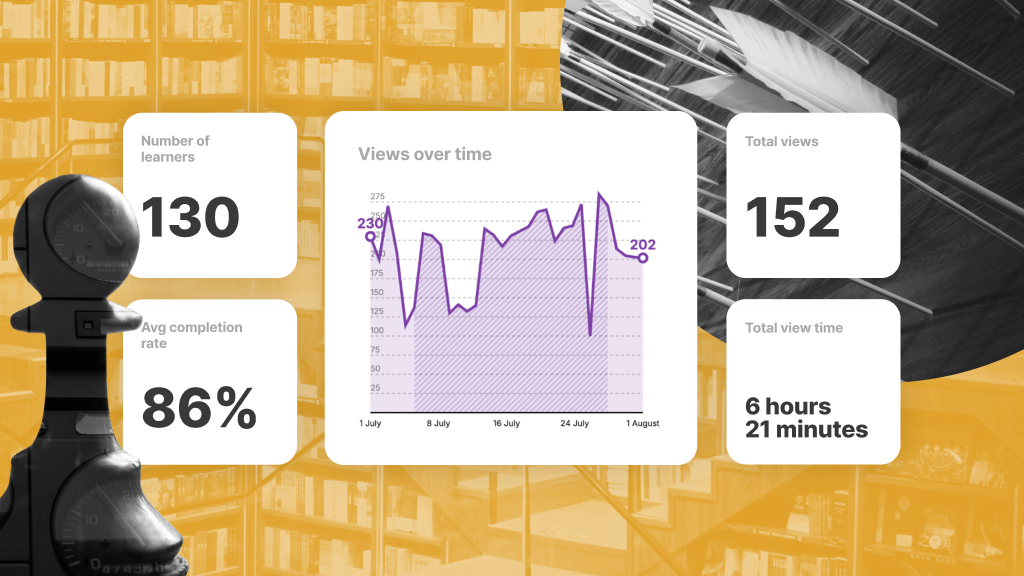12 benefits of asynchronous learning

In today’s remote-first workplaces, the benefits of asynchronous learning are becoming increasingly evident, especially for organizations with global workforces. With employees dispersed across international time zones, live group training can be problematic. And bringing people together from great distances for in-person training can be a major logistical and financial undertaking.
For these reasons and more, organizations have much to gain from asynchronous learning.
The many benefits of asynchronous learning
Asynchronous learning is best understood for what it is not. It is not sitting in a classroom alongside other learners with an instructor leading a lecture. And it isn’t attending a scheduled webinar in real-time. But record a lecture or webinar and make it available for use by anyone in the organization, and it becomes asynchronous learning.
Asynchronous learning is essentially individuals learning on their own, without the direct intervention of an instructor or facilitator. Here are 12 ways asynchronous learning benefits both employees and organizations.
Asynchronous learning is cost-effective
The cost benefits of asynchronous learning are impressive. When learning occurs asynchronously, there’s no ongoing need for a live instructor or a physical learning environment that accommodates a certain number of people. An instructor can deliver a training once, with the event recorded for future use, potentially for years to come. The venue, travel, and seat time costs of bringing employees together, as well as the associated loss of productivity, are eliminated.
In many cases, material for asynchronous learning can be acquired from reputable vendors, such as eLearning and video content providers. When this is possible, organizations trade the high cost of in-house development for the lower cost of evaluating and curating additions to their internal training catalog.
It’s easily scaled
Once asynchronous learning materials have been developed or acquired, they can be used by any number of people without significantly increasing training costs. Employees simply access the training they need from the organization’s LMS or LXP.
Scalability can come at an extra cost when sourcing content externally, as many plan-based providers only allow a certain number of users and exceeding that number requires the organization to upgrade. However, some content providers like Big Think+ offer unlimited licenses for internal users with all partnerships.

Asynchronous learning eliminates geographical constraints
The benefits of asynchronous learning are particularly significant for international organizations, as it eliminates constraints on where employees learn. As long as asynchronous learning is optimized for use on mobile devices, meaning it follows the best practices of mLearning design, employees can learn anywhere they have internet access.
It offers a consistent experience
When an instructor-led program is delivered multiple times, there will be some degree of inconsistency in the content and how it is presented. Even greater inconsistency is likely when multiple instructors deliver the same program. Inconsistent content delivery can lead to inconsistent job performance, and asynchronous learning eliminates that variability.
It meets the need for on-demand learning
On-demand learning is not new, but it has become an increasingly popular method of choice since the COVID-19 pandemic. Employees prefer to learn whenever and wherever they want. A recent study revealed that 74% of employees want to learn during their spare time at work. And another shows more than half of employees prefer learning at their own pace.
One of the great benefits of asynchronous learning is that it can occur at any time and in any location. Offering a relevant training experience in the moment, when a learner most needs it, means they’re even more likely to take the opportunity to engage with the content and remember the information. Organizations can use it as a way to meet workers right where they’re at.
Asynchronous learning permits repetition
In the late 19th century, German psychologist Hermann Ebbinghaus explored the nature of memory and discovered that much of what people learn is lost within a day or two. He graphed the results of his experiments in what has become known as the Ebbinghaus Forgetting Curve.
Repetition helps combat that loss and with asynchronous learning, employees can revisit learning programs as often as needed. A report from the National Institutes of Health confirms the benefits of re-studying and highlights the positive impact on comprehension and retention of being able to control one’s own study time.
It leaves employees feeling empowered
Another one of the key benefits of asynchronous learning is that it leaves employees feeling empowered by having the autonomy and resources they need to exercise a high degree of control over their own learning. Employees should have a great deal of latitude in how they meet their learning goals. When learning is overly prescriptive, it dampens their enthusiasm.
It supports different learning styles
There is some controversy in the L&D world over the theory that learning styles are hard-wired into how the brain acquires, processes, and stores information. Many believe that learning styles are a matter of preference, not innate characteristics. Either way, being able to learn in a way that one finds most comfortable or effective is one of the main benefits of asynchronous learning.
In synchronous learning, it’s difficult to differentiate instruction enough to accommodate all learning styles equally well. It is possible, though, to develop content in multiple modalities for asynchronous use, each targeting a different learning style — for example, a video for visual learners, a podcast for auditory learners, an eBook for those who prefer to learn by reading, and a hands-on activity for kinesthetic learners.
Asynchronous learning allows employees to get answers in real-time
In a synchronous learning situation, learners may not be able to ask questions as they occur to them. Their questions may even go unanswered due to time constraints or an instructor’s need to do further research in order to provide an accurate response.
But with asynchronous learning, learners’ actions aren’t limited by an agenda over which they have no control. There’s nothing to prevent them from looking up an unfamiliar term or searching online for relevant examples in-the-moment, and then continuing their learning.
It accommodates learners with disabilities
The benefits of asynchronous learning are particularly meaningful for people with disabilities because it enables them to take advantage of certain accessibility accommodations. Because asynchronous learning typically does not occur in a shared space, there’s no need to be concerned about disturbing others.
For example, a learner who is hearing impaired can turn on captions or simply crank the volume up when watching a video-based program. And visually impaired learners can activate a screen reader, without having to use earphones.
It supports the reinforcement of learning
Reinforcement is another way to enhance the retention of skills and knowledge, and asynchronous learning materials can be powerful reinforcers. For example, after completing a training program, learners can access follow-up activities, assessments, videos, and other related materials on their own time that expand upon what they learned.
It helps build a culture of lifelong learning
Perhaps the most significant of the benefits of asynchronous learning is that it makes learning commonplace and visible, not something that must be scheduled or mandated. When learning is a visible part of the everyday work environment, it becomes ingrained in an organization’s culture. And the benefits of a learning culture are numerous, including an increased ability for the organization to adapt to volatile conditions.
Final note
Moving farther in the direction of asynchronous learning does not mean leaving learners adrift in a sea of information with no idea where they’re heading. Asynchronous learning programs can be part of a more comprehensive learning pathway or specified in an individual’s development plan. There may be post-training follow-up with a supervisor, L&D staff, or a mentor.
Learners may complete an asynchronous program and be interested in exploring the subject further. L&D can facilitate by creating an online forum in which learners can engage in discussion with their peers and share reactions, comments, or questions. L&D staff can also post assignments and quizzes to reinforce key points.
There are many ways to take advantage of the benefits of asynchronous learning. When designed well, it can make continuous learning the hallmark of an organization’s culture.





